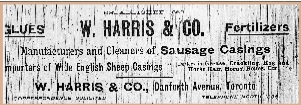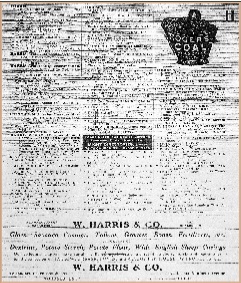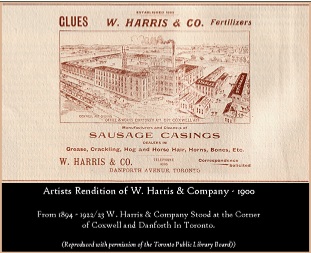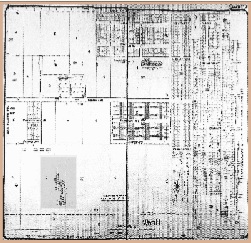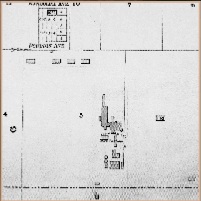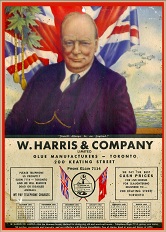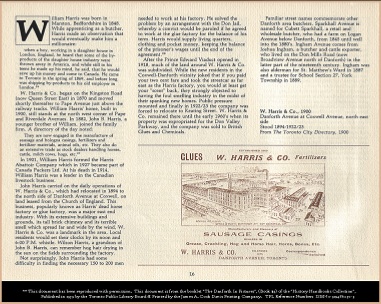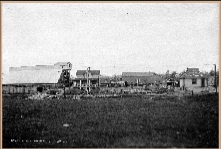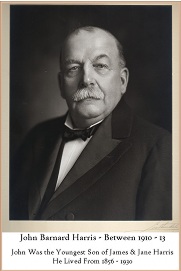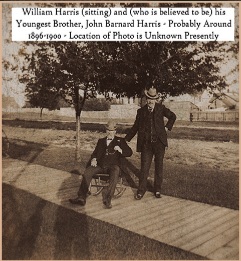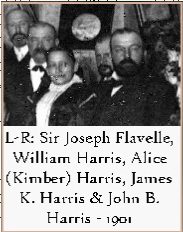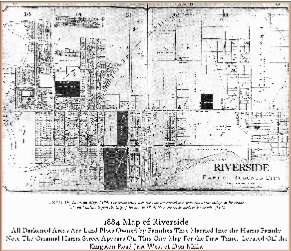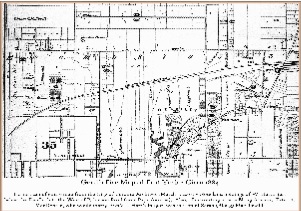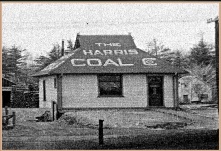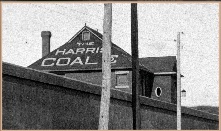W. Harris & Company 1870-1960
According to archival information, W. Harris & Company was incorporated in 1870. It is assumed that William was expecting one or both of his brothers (James & John Barnard) to emigrate and join him in this business venture over the next few years - they would more than likely have been the "Company" portion of W. Harris & Company. Based on census & immigration records it is unclear exactly how John B. Harris initially fit into the organization, but it is assumed that he was a partner in this business with William from 1872-78 and then from 1880 onwards. Starting in early 1895 William Harris (along with his two eldest sons, William Thomas & James) opened another livestock related business that would become nationally known as the Harris Abattoir . In 1927 this company (along with several others) would be renamed Canada Packers, Today it is internationally known as Maple Leaf Foods.
William was still the controlling partner at W. Harris & Company at the time of his death on May 11, 1914. It is clear that William's other brother, James Harris, was not at any time employed by, or in control of any facet of W. Harris & Company.
Below are the basic biographies of James K. & John Barnard Harris. They are based on many small bits of knowledge I have obtained via the kindness of others and my family research over the last few years. Of course, any type of information that you, the reader, can offer is encouraged and would be greatly appreciated.
If you have questions or feedback regarding any of the information contained on this page, please click here to forward your message.
James K. Harris (August 13, 1854 - October 9, 1925)
*** Jim's middle initial "K" is not evident on any documents aside from business listings from 1898 onwards - it is unknown if he actually had a middle name or whether he simply added the "K" himself ***
James Harris left Marston for Canada in the November of 1879 and returned to Marston on April 7, 1880 only to leave Marston and go back to Canada a week later later on April 14, 1880...this time with his wife, Martha Tipler (1853-1884) and their existing children. James & his family also settled in Toronto. Instead of joining William in the rendering business he opened a grocery store. It is noted on the birth certificate of his daughter Emily (born 1882) that James was a Grocer by trade and they resided at 365 Queen Street East. It is assumed that the grocery store that James operated was located at this address as well. In a letter dated October 15, 1982, written to Joan (Harris) Macrae by Lois (DeCoursey) Phasey (James Harris' granddaughter), Lois notes that the Toronto home address of Jim & his second wife, Pamillia (Irwin) Harris, was 120 Queen Street East. According to Lois, James owned the entire block at that time. It is assumed that he moved from 365 Queen St. to 120 Queen St. around 1885 - shortly after the death of his wife Martha on March 4, 1884. To view Lois' letter to Joan, please follow the links below:
Lois' Letter - Page #1 - Page #2
According to archival information, W. Harris & Company was incorporated in 1870. It is assumed that William was expecting one or both of his brothers (James & John Barnard) to emigrate and join him in this business venture over the next few years - they would more than likely have been the "Company" portion of W. Harris & Company. Based on census & immigration records it is unclear exactly how John B. Harris initially fit into the organization, but it is assumed that he was a partner in this business with William from 1872-78 and then from 1880 onwards. Starting in early 1895 William Harris (along with his two eldest sons, William Thomas & James) opened another livestock related business that would become nationally known as the Harris Abattoir . In 1927 this company (along with several others) would be renamed Canada Packers, Today it is internationally known as Maple Leaf Foods.
William was still the controlling partner at W. Harris & Company at the time of his death on May 11, 1914. It is clear that William's other brother, James Harris, was not at any time employed by, or in control of any facet of W. Harris & Company.
Below are the basic biographies of James K. & John Barnard Harris. They are based on many small bits of knowledge I have obtained via the kindness of others and my family research over the last few years. Of course, any type of information that you, the reader, can offer is encouraged and would be greatly appreciated.
If you have questions or feedback regarding any of the information contained on this page, please click here to forward your message.
James K. Harris (August 13, 1854 - October 9, 1925)
*** Jim's middle initial "K" is not evident on any documents aside from business listings from 1898 onwards - it is unknown if he actually had a middle name or whether he simply added the "K" himself ***
James Harris left Marston for Canada in the November of 1879 and returned to Marston on April 7, 1880 only to leave Marston and go back to Canada a week later later on April 14, 1880...this time with his wife, Martha Tipler (1853-1884) and their existing children. James & his family also settled in Toronto. Instead of joining William in the rendering business he opened a grocery store. It is noted on the birth certificate of his daughter Emily (born 1882) that James was a Grocer by trade and they resided at 365 Queen Street East. It is assumed that the grocery store that James operated was located at this address as well. In a letter dated October 15, 1982, written to Joan (Harris) Macrae by Lois (DeCoursey) Phasey (James Harris' granddaughter), Lois notes that the Toronto home address of Jim & his second wife, Pamillia (Irwin) Harris, was 120 Queen Street East. According to Lois, James owned the entire block at that time. It is assumed that he moved from 365 Queen St. to 120 Queen St. around 1885 - shortly after the death of his wife Martha on March 4, 1884. To view Lois' letter to Joan, please follow the links below:
Lois' Letter - Page #1 - Page #2
On January 21, 1885 James married Pamillia Irwin (1856-1919) of Burlington. In 1887 (for reasons not known yet) Jim sold his business &assests and moved the entire family to Chicago, Illinois, U.S.A. Once there James became a well known Restauranteur. Lois also states that around this time John Barnard Harris, one of James' sons that he had with his first wife Martha Tipler, died of Typhoid. Recent research led to the discovery of J.B. Harris' death registration, and sadly he did pass away in Chicago in 1892. Lois' letter goes on to say that James was a successful and respected Chicago businessman. He joined the Masons and he made many important friends within the Chicago business community. James' tenure as a successful Chicago Restauranteur seems to have been a short lived reality although. While James and his family were living in Chicago (around 1895 time possibly) Jim became separated from a very large portion of his money & property.
James' descendant's maintain that he loaned a fellow Mason brother $80,000.00 An excessely large amount of money in the 1890's; and for that matter, a considerable sum even by today's standards. Suffice to say, his Lodge brother miraculously disappeared shortly after the loan was finalized. James never did see this man or his $80,000.00 ever again.
Following this financial devastation, it seems that James and his family took whatever they had left and bought an inexpensive, yet scenic piece of land in Choteau, Montana - with the intention of ranching. In 1897/8, while digging a well, James (like many others in the day) struck a vein of copper - a very large and prosperous one. He then opened a copper mine on that land, making back his previous losses quite quickly and buying up other properties in the area for prospecting and/or ranching purposes. By the early 1900's James sold his mine to the a booming company from Butte called Anaconda Copper. The business address of this mine was in Great Falls, Montana. Both he and Pamillia would live the rest of their days in Choteau, Montana.
In 1979 the descendants of James Harris/Martha Tipler/Pamillia Irwin were very surprised to find out that James had reserved a portion of the mineral rights to the Choteau ranch land for his family about a year before he died. It was, although, not specified in his will. "Hunt Brothers" now lease the land rights from Jim's descendants. The area is now known as the "Overthrust Belt", or more specifically, "The Deep Creek Project".
John Barnard Harris (September 18, 1856 - January 22, 1930)
John Barnard Harris was the youngest of the four brothers. He originally came to Canada in 1872 with the newly married William and Caroline (Richardson) Harris. Based on immigration records, John originally resided at 355 Strathmore Avenue, Toronto. John did not stay in Toronto for very long. By 1873 he was a Butcher's apprentice in London, Ontario. In 1878 he left London, Ontario to once again return to England. John came back to Canada in 1880 and again settled in London. It was not until John married Alice Kimber (1858-1926) in Toronto on May 23, 1881 that he is noted as residing in Toronto. The first child born to Alice & John was William George Harris on April 6, 1882. William George is noted as being born in Middlesex County, London, Ontario. Even though John appears to have been residing with his family in London until as late as 1883, John became a partner in W. Harris & Company in mid 1882. It is very possible that John was involved in the company in some other way, i.e. sending business to Toronto from London. This is still being researched.
John and his family initially lived at 924 Danforth Road. In 1885 they would move to 1624 Danforth Road. It is at this address that John and Alice would remain for the remainder of their lives.
John and his sons assumed total control of W. Harris & Company after William Harris' death on May 11, 1914. John's descendants continued to administer and operate W. Harris & Company until 1960/61 when the area of Keating Street was obtained by the city of Toronto in order to construct the Don Valley Parkway. In 1961 W. Harris & Company was sold to British Glue and Chemical. It had been in business for exactly 90 years.
From roughly 1890 until 1923 (?) John and his son's also owned and operated the Harris Coal Company as well.
John's middle son, Joseph Henry Harris, or simply "Joe" as he preferred, (b. December 13, 1888 - d. October 25, 1952) was elected to the Canadian House of Commons. Joe was initially elected as a Federal Member of Parliament (MP) for the York East Riding in the 1921 Canadian election. During his lifetime he would also serve as the Federal M.P. for both the Danforth & Toronto-Scarborough ridings (this riding was renamed from the Toronto-Scarborough Riding to the Danforth Riding in 1933). Lastly, Joe was elected in 1949 to the Danforth Riding - he died while in office on October 25, 1952. He remains the longest running incumbent Federal politician in Canadian history. During his 31 years as a member of Parliament he was affectionately known as "Silent Joe Harris" - meaning that he was never really "silent" at all. Joe's greatest accomplishment while in office was the concept & construction of the Toronto East General Hospital. To see an image of him at the Hospital's official opening in 1929, click here.
To view Joe's profile on Wikipedia, click here.
To see Joe Harris' obituary with his photo, click here
In 1938, during the Conservative leadership convention, Joseph was nominated and ran for the Federal Conservative party leader seat. He placed third in the race. He would not run for this title again.
In total, Joe was re-elected an impressive 8 times in his chosen riding.
John Barnard Harris is cited in Toronto history as a "Danforth Pioneer".
"Harris Avenue", a small road that runs East/West in East York, located one block north of Danforth Avenue and one block West of Main Street between Oak Park Avenue to the West and Chisholm Avenue to the East, was named in John's memory. Harris Park Drive, another street located in East York, is named after John's son, Joseph H. Harris. Originally, a Park was dedicated to Joe's memory - but the park was built over when the Eglinton Square Plaza was constructed. Harris Park Drive is situated between Pharmacy Avenue and Victoria Park Avenue, North of Saint Clair Avenue East. It runs North/South from Arvington Road (North end) to Edge Park Avenue (South End).
James' descendant's maintain that he loaned a fellow Mason brother $80,000.00 An excessely large amount of money in the 1890's; and for that matter, a considerable sum even by today's standards. Suffice to say, his Lodge brother miraculously disappeared shortly after the loan was finalized. James never did see this man or his $80,000.00 ever again.
Following this financial devastation, it seems that James and his family took whatever they had left and bought an inexpensive, yet scenic piece of land in Choteau, Montana - with the intention of ranching. In 1897/8, while digging a well, James (like many others in the day) struck a vein of copper - a very large and prosperous one. He then opened a copper mine on that land, making back his previous losses quite quickly and buying up other properties in the area for prospecting and/or ranching purposes. By the early 1900's James sold his mine to the a booming company from Butte called Anaconda Copper. The business address of this mine was in Great Falls, Montana. Both he and Pamillia would live the rest of their days in Choteau, Montana.
In 1979 the descendants of James Harris/Martha Tipler/Pamillia Irwin were very surprised to find out that James had reserved a portion of the mineral rights to the Choteau ranch land for his family about a year before he died. It was, although, not specified in his will. "Hunt Brothers" now lease the land rights from Jim's descendants. The area is now known as the "Overthrust Belt", or more specifically, "The Deep Creek Project".
John Barnard Harris (September 18, 1856 - January 22, 1930)
John Barnard Harris was the youngest of the four brothers. He originally came to Canada in 1872 with the newly married William and Caroline (Richardson) Harris. Based on immigration records, John originally resided at 355 Strathmore Avenue, Toronto. John did not stay in Toronto for very long. By 1873 he was a Butcher's apprentice in London, Ontario. In 1878 he left London, Ontario to once again return to England. John came back to Canada in 1880 and again settled in London. It was not until John married Alice Kimber (1858-1926) in Toronto on May 23, 1881 that he is noted as residing in Toronto. The first child born to Alice & John was William George Harris on April 6, 1882. William George is noted as being born in Middlesex County, London, Ontario. Even though John appears to have been residing with his family in London until as late as 1883, John became a partner in W. Harris & Company in mid 1882. It is very possible that John was involved in the company in some other way, i.e. sending business to Toronto from London. This is still being researched.
John and his family initially lived at 924 Danforth Road. In 1885 they would move to 1624 Danforth Road. It is at this address that John and Alice would remain for the remainder of their lives.
John and his sons assumed total control of W. Harris & Company after William Harris' death on May 11, 1914. John's descendants continued to administer and operate W. Harris & Company until 1960/61 when the area of Keating Street was obtained by the city of Toronto in order to construct the Don Valley Parkway. In 1961 W. Harris & Company was sold to British Glue and Chemical. It had been in business for exactly 90 years.
From roughly 1890 until 1923 (?) John and his son's also owned and operated the Harris Coal Company as well.
John's middle son, Joseph Henry Harris, or simply "Joe" as he preferred, (b. December 13, 1888 - d. October 25, 1952) was elected to the Canadian House of Commons. Joe was initially elected as a Federal Member of Parliament (MP) for the York East Riding in the 1921 Canadian election. During his lifetime he would also serve as the Federal M.P. for both the Danforth & Toronto-Scarborough ridings (this riding was renamed from the Toronto-Scarborough Riding to the Danforth Riding in 1933). Lastly, Joe was elected in 1949 to the Danforth Riding - he died while in office on October 25, 1952. He remains the longest running incumbent Federal politician in Canadian history. During his 31 years as a member of Parliament he was affectionately known as "Silent Joe Harris" - meaning that he was never really "silent" at all. Joe's greatest accomplishment while in office was the concept & construction of the Toronto East General Hospital. To see an image of him at the Hospital's official opening in 1929, click here.
To view Joe's profile on Wikipedia, click here.
To see Joe Harris' obituary with his photo, click here
In 1938, during the Conservative leadership convention, Joseph was nominated and ran for the Federal Conservative party leader seat. He placed third in the race. He would not run for this title again.
In total, Joe was re-elected an impressive 8 times in his chosen riding.
John Barnard Harris is cited in Toronto history as a "Danforth Pioneer".
"Harris Avenue", a small road that runs East/West in East York, located one block north of Danforth Avenue and one block West of Main Street between Oak Park Avenue to the West and Chisholm Avenue to the East, was named in John's memory. Harris Park Drive, another street located in East York, is named after John's son, Joseph H. Harris. Originally, a Park was dedicated to Joe's memory - but the park was built over when the Eglinton Square Plaza was constructed. Harris Park Drive is situated between Pharmacy Avenue and Victoria Park Avenue, North of Saint Clair Avenue East. It runs North/South from Arvington Road (North end) to Edge Park Avenue (South End).
INTRODUCTION
In order to understand the development and history of the early companies it is of some importance to understand who formed these businesses and also where they existed geographically. Included in this section of the website is some general historical information regarding the city of Toronto (York). You will also have the opportunity to read some basic biographical information of William Harris (February 14, 1848 - May 11, 1914) & his two younger brothers, James & John Barnard Harris. Upon completion, it is hoped that you can better understand what transpired in the latter part of the 19th century on the East side of the Don River in the County of York to a family named Harris.
The Area of East Toronto From 1860-1900
Certain portions of Toronto East have been, and still are commonly referred to as Leslieville, Riverdale, East Toronto, The Danforth, and Midway. Riverdale, Leslieville & Midway are where the Harris families & companies existed during this time.
Click here to take a look at a diagram of Toronto with the areas & dates of annexation from 1834-1914.
When W. Harris & Company was incorporated in 1870 on the Kingston Road (Queen Street East) this area of "York County" was not yet formally a part of Toronto. The primary reason for this lack of municipal inclusion was the geographical boundaries posed by the Don River & its many tributaries. Those that resided to the South of Queen Street East and to the West of MacLean Avenue (between Victoria Park & Woodbine) were part of the original city plan of 1834. It is of some importance to mention that during this time the lands South of Queen Street East from (what is now) Bayview Avenue in the West to Maclean Street in the East, were not much more than farms & forest. This area was being rapidly settled and would become home to a building population that was steadily increasing with each passing year.
During this time access to the formal city of Toronto from anywhere East of the Don River was obtained by crossing the Queen Street Bridge (sometimes called the Don Bridge). Other bridges did exist at the time, namely the Winchester Bridge (Winchester Street) and Bell's Bridge (Gerrard Street); but they were considered "rickety" and could not sustain large carriages or wagons carrying heavy loads.
If you were to cross the Queen Street bridge in the 1870's, coming from Kingston Road in the East, you would encounter a fork in the road at King & Queen Street West. Queen Street lead directly West and King Street would take you Southwest to a short bridge that spanned Taddle Creek. Once across this bridge, King Street led directly West as well; now running parallel to, and one block South of Queen Street West. Aside from larger and busier travelways, this road map is basically the same today.
To view the York City Plan Map of 1818, showing Queen Street, the Kingston Road and the Queen Street/Don Bridge, please click here. To see this map without the added writing, please click here.
The Harris Family of Marston, Bedfordshire, England
William Harris was born on February 14, 1848 in Marston, Bedfordshire, England. He was the second son, and second child to James and Jane (Barnard) Harris. William was one of seven children born to the couple.
His older brother's name was Richard Mortayne (July 2, 1846 - January 24, 1895), and his younger siblings (in order of birth) were Mary (Wells), Louisa (Tipler), James, John Barnard and Caroline (Parker).
In 1866 William was a butcher's apprentice in London, England. He overheard that in Canada when a farm animal dies it is simply left to "rot in the sun". Of course, this statement was not completely factual. In England, an animal carcass was not wasted; it was a commodity that was purchased for a small sum by a "dealer." William's father, James Harris, had spent several years of his life as a local dealer, as did James' father (Richard Harris) before him.
In order to understand the development and history of the early companies it is of some importance to understand who formed these businesses and also where they existed geographically. Included in this section of the website is some general historical information regarding the city of Toronto (York). You will also have the opportunity to read some basic biographical information of William Harris (February 14, 1848 - May 11, 1914) & his two younger brothers, James & John Barnard Harris. Upon completion, it is hoped that you can better understand what transpired in the latter part of the 19th century on the East side of the Don River in the County of York to a family named Harris.
The Area of East Toronto From 1860-1900
Certain portions of Toronto East have been, and still are commonly referred to as Leslieville, Riverdale, East Toronto, The Danforth, and Midway. Riverdale, Leslieville & Midway are where the Harris families & companies existed during this time.
Click here to take a look at a diagram of Toronto with the areas & dates of annexation from 1834-1914.
When W. Harris & Company was incorporated in 1870 on the Kingston Road (Queen Street East) this area of "York County" was not yet formally a part of Toronto. The primary reason for this lack of municipal inclusion was the geographical boundaries posed by the Don River & its many tributaries. Those that resided to the South of Queen Street East and to the West of MacLean Avenue (between Victoria Park & Woodbine) were part of the original city plan of 1834. It is of some importance to mention that during this time the lands South of Queen Street East from (what is now) Bayview Avenue in the West to Maclean Street in the East, were not much more than farms & forest. This area was being rapidly settled and would become home to a building population that was steadily increasing with each passing year.
During this time access to the formal city of Toronto from anywhere East of the Don River was obtained by crossing the Queen Street Bridge (sometimes called the Don Bridge). Other bridges did exist at the time, namely the Winchester Bridge (Winchester Street) and Bell's Bridge (Gerrard Street); but they were considered "rickety" and could not sustain large carriages or wagons carrying heavy loads.
If you were to cross the Queen Street bridge in the 1870's, coming from Kingston Road in the East, you would encounter a fork in the road at King & Queen Street West. Queen Street lead directly West and King Street would take you Southwest to a short bridge that spanned Taddle Creek. Once across this bridge, King Street led directly West as well; now running parallel to, and one block South of Queen Street West. Aside from larger and busier travelways, this road map is basically the same today.
To view the York City Plan Map of 1818, showing Queen Street, the Kingston Road and the Queen Street/Don Bridge, please click here. To see this map without the added writing, please click here.
The Harris Family of Marston, Bedfordshire, England
William Harris was born on February 14, 1848 in Marston, Bedfordshire, England. He was the second son, and second child to James and Jane (Barnard) Harris. William was one of seven children born to the couple.
His older brother's name was Richard Mortayne (July 2, 1846 - January 24, 1895), and his younger siblings (in order of birth) were Mary (Wells), Louisa (Tipler), James, John Barnard and Caroline (Parker).
In 1866 William was a butcher's apprentice in London, England. He overheard that in Canada when a farm animal dies it is simply left to "rot in the sun". Of course, this statement was not completely factual. In England, an animal carcass was not wasted; it was a commodity that was purchased for a small sum by a "dealer." William's father, James Harris, had spent several years of his life as a local dealer, as did James' father (Richard Harris) before him.

***Author's Note To All Readers***
The following information has been gathered and assembled over an ten-year period of time.
Certain deductions/assumptions have been made when or where data was lacking. Of course, these deductions/assumptions are open for debate, confirmation or denial. If any reader feels that any piece of information included in this document is inaccurate in any way, I encourage you to contact me with what you believe to be the correct information.
The complete and accurate documentation of information regarding Toronto business history, such as W. Harris and Company and the Harris Coal Company brings forth much theory and legend. Some of the following information has been deduced utilizing passed down information, letters, local history, and the author's personal knowledge.
Bearing these thoughts in mind, please be patient and understanding while reading the following information.
Thank You;
J. F. Harris - April, 2012
The following information has been gathered and assembled over an ten-year period of time.
Certain deductions/assumptions have been made when or where data was lacking. Of course, these deductions/assumptions are open for debate, confirmation or denial. If any reader feels that any piece of information included in this document is inaccurate in any way, I encourage you to contact me with what you believe to be the correct information.
The complete and accurate documentation of information regarding Toronto business history, such as W. Harris and Company and the Harris Coal Company brings forth much theory and legend. Some of the following information has been deduced utilizing passed down information, letters, local history, and the author's personal knowledge.
Bearing these thoughts in mind, please be patient and understanding while reading the following information.
Thank You;
J. F. Harris - April, 2012
The images below can be viewed full size by clicking on them. To save the image to your computer, just right click (on the enlarged image) and choose the "save picture as" option from the pop up list.
1902 - Company Ad Published in the
Toronto City Directory
Toronto City Directory
1913 - Company ad published in the
Toronto City Directory - Business address & managers can be seen in left side column
Toronto City Directory - Business address & managers can be seen in left side column
The only image I have found of
the W. Harris & Company plant
at Coxwell & Danforth - around 1900
the W. Harris & Company plant
at Coxwell & Danforth - around 1900
1898 Goad's Fire Map of
Midway (East York) showing
the glue factory (shaded grey area)
Midway (East York) showing
the glue factory (shaded grey area)
Detail of 1898 Goad's Map
Note that Coxwell does not
yet meet with Danforth
Note that Coxwell does not
yet meet with Danforth
1941 Wall Calendar - address of plant
is given as Keating Street, this was the
last known address of the Company
(J.F. Harris Archive Item)
is given as Keating Street, this was the
last known address of the Company
(J.F. Harris Archive Item)
Taken from the booklet "The Danforth in Pictures"
This is the most information I have found to date on
"W. Harris & Company."
(Published by the Toronto Public Library - 1979)
This is the most information I have found to date on
"W. Harris & Company."
(Published by the Toronto Public Library - 1979)
The Harris Coal Company in 1913
Little is known of this company aside from the fact that is was started and controlled by John Barnard Harris & Sons. It existed from about 1908-1956 in the area around the Toronto East General Hospital. It was eventually bought out by Elias Rogers Co. Images of Harris Coal Company Courtesy of W.B.G. Humphries.
Little is known of this company aside from the fact that is was started and controlled by John Barnard Harris & Sons. It existed from about 1908-1956 in the area around the Toronto East General Hospital. It was eventually bought out by Elias Rogers Co. Images of Harris Coal Company Courtesy of W.B.G. Humphries.
John Barnard Harris
1911
1911
John & William Harris
Around 1896/7?
Around 1896/7?
James K. Harris & Brothers
1901
1901
Richard Mortayne Harris
of Australia - Around 1877
of Australia - Around 1877
William Harris
1911
1911
The Harris Brothers of Marston, Bedfordshire, England
William completed his apprenticeship in Toronto while working for the William Davies Company as a Butcher between April 1870 & February 1872. William incorporated W. Harris & Company while in the employ of William Davies.
The William Davies Company (founded in 1854 by William Davies) was involved in some basic forms of rendering and had been for close to 20 years; but the primary business of Davies was meat packing and export - mostly hogs at the time.
By late 1871 William Harris had formally incorporated a business in Leslieville. In 1878 William was listed as being a "Sausage Maker" working in Leslieville. Even though W. Harris & Company was incorporated and actively obtaining business by 1873, it is possible that William continued to work at the William Davies Company in some capacity while he set up the rendering business. One should assume that Mr. Davies had a hand in the birth of W. Harris & Company - he surely would have been a worthy role model to William at this time.
Shortly before his 24th Birthday (February 14, 1872) William returned to England, landing at Liverpool on March 1, 1872. On May 25, 1872 William married Caroline Richardson in Marston, Bedfordshire, England. Just two days later, on May 27, 1872, they would both board a ship destined for Montreal...along with the newlyweds was William's 16 year old brother, John Barnard Harris. On June 14, 1872 all three of them arrived in Toronto. William & Caroline settled East of the Don River. Initially it seems that they lived on the west end of the Kingston Road, but this has not been verified. In 1873/4 William built a house on the Southern end (west side) of Robinson Road - Robinson Road is currently known as Pape Avenue (Pape's Lane before it was formally named). In later years the property that this home existed upon would be known as 320 Pape Avenue (1881-1891), 420 Pape Avenue (1891-98) & lastly, 450 Pape Avenue (1899-Present Day). The William Harris House at 450 Pape Avenue was sold to the Salvation Army by William's youngest son, Joseph Harris, in 1927 shortly after the death of Caroline (Richardson) Harris for $20,000.00. Currently the home is a Toronto Heritage Property (as of August 2010) and is owned by The Rose & Thistle Group. As of April 2012 they describe the home and the plans for the home as follows: "A historically designated mansion which we are renovating into a 12-plex situated on .5 acres of land on which we are building town-homes."
The William Davies Company (founded in 1854 by William Davies) was involved in some basic forms of rendering and had been for close to 20 years; but the primary business of Davies was meat packing and export - mostly hogs at the time.
By late 1871 William Harris had formally incorporated a business in Leslieville. In 1878 William was listed as being a "Sausage Maker" working in Leslieville. Even though W. Harris & Company was incorporated and actively obtaining business by 1873, it is possible that William continued to work at the William Davies Company in some capacity while he set up the rendering business. One should assume that Mr. Davies had a hand in the birth of W. Harris & Company - he surely would have been a worthy role model to William at this time.
Shortly before his 24th Birthday (February 14, 1872) William returned to England, landing at Liverpool on March 1, 1872. On May 25, 1872 William married Caroline Richardson in Marston, Bedfordshire, England. Just two days later, on May 27, 1872, they would both board a ship destined for Montreal...along with the newlyweds was William's 16 year old brother, John Barnard Harris. On June 14, 1872 all three of them arrived in Toronto. William & Caroline settled East of the Don River. Initially it seems that they lived on the west end of the Kingston Road, but this has not been verified. In 1873/4 William built a house on the Southern end (west side) of Robinson Road - Robinson Road is currently known as Pape Avenue (Pape's Lane before it was formally named). In later years the property that this home existed upon would be known as 320 Pape Avenue (1881-1891), 420 Pape Avenue (1891-98) & lastly, 450 Pape Avenue (1899-Present Day). The William Harris House at 450 Pape Avenue was sold to the Salvation Army by William's youngest son, Joseph Harris, in 1927 shortly after the death of Caroline (Richardson) Harris for $20,000.00. Currently the home is a Toronto Heritage Property (as of August 2010) and is owned by The Rose & Thistle Group. As of April 2012 they describe the home and the plans for the home as follows: "A historically designated mansion which we are renovating into a 12-plex situated on .5 acres of land on which we are building town-homes."
In the 1870's the County of York, urged by those that lived near the rendering plant, successfully launched a lawsuit against W. Harris & Company of Queen Street (now Kingston Road). In actuality the lawsuit was launched against the "Harris Brothers". It is not known why this is. It is possible that the company underwent a name change from "Harris Brothers Rendering" to "W. Harris & Company" at some point in the late 1870's but there is no evidence to support this theory aside from the lawsuit. Citations for the pollution of air and water, as well as noise pollution topped the list. Generally, it seems that the now rapidly growing residential area was not at all happy with the noxious smells that emanated from the factory windows & smoke stacks.
The lawsuit imposed certain conditions as stipulated by the city (these conditions are not currently known to this writer). These new "standards" resulted in a series of un-patented devices created by William in order to make the business more tolerable for those that lived in the area and safer for the employees that toiled within the plant. It was during this time that William devised a basic mechanical "assembly line" within the rendering plant. Other various measures were undertaken in order to ease the grumbles of those that lived within nose-shot of the pungent factory. Much to William & John's frustration, these innovations did not sufficiently satisfy the locals for very long. Around 1881/82 W. Harris & Company relocated to Pape Avenue north of Kingston Road - occupying land around what today would be the area of Pape & Bain. William's home was basically across the street from this new location, maybe this was his attempt to demonstrate that he was willing to live in the area of his own industrial fumes?
In 1893 the business was once again forced to relocate from Pape Avenue for basically the same reasons as why it had to relocate ten years prior. By this time William and John Harris were reaping great financial rewards and they could afford to erect a modern and expansive plant. They relocated to another less residential area of York East. The new plant was built about 100 feet back from the north side of the Don Road... now known as Danforth Avenue. The north end of the factory was about 150 feet from the corner of Poulton Avenue (east-west) and Coxwell Avenue (north-south). When the factory was built, Coxwell Avenue did not connect to the Danforth. The actual street address of the plant in 1913 was 974-994 Danforth Avenue. William & John erected a very large (for the standards of the day) factory occupying an area of about 2 city blocks. The factory was constructed in the middle of a large field. At the time of construction there were no residential roads within 100-200 feet of the factory walls. Once again, as the area grew in population many locals complained of the odor the factory spewed into the neighbourhood. By this time the business had become a major employer in the area and it's location had been judged as being far enough away from any residential area. There was little need for William & John to fear yet another community eviction....for a few years at least.
On September 22, 1900 W. Harris & Company mysteriously burnt to the ground and had to be re-built. It was shortly after this time that William seemed to slowly withdraw himself from the rendering business. From 1900 onwards John B. Harris and his son's were basically in control of the company as far as daily operations & management.
W. Harris & Company remained at Danforth & Coxwell until 1922 when, for the last time, it re-located
to an industrial area of Toronto at #200 Keating Avenue (now Lakeshore Blvd) - this was a convenient location primarily due to the access the company now had to the Keating Channel. Operations were carried on as usual within the Keating Street plant under the direction of John B. Harris' sons and grandsons following John's death on June 22 1930. In 1960 the land around the factory was desired by the city in order to construct the much needed Don Valley Parkway. In 1961, John's grandson, Wilson Barnard Harris, sold W. Harris & Company to British Glue & Chemical. A 90 year era had come to a close.
Around 1895 William began to re-design and incorporate a similar style of the mechanical assembly line that he initially designed for use in the rendering plant. These more modern and efficient labor saving devices were utilized within the Harris Abattoir meat packing plants. William labeled these devices "kill floor conveyors" William's conveyors did not directly resemble the modern assembly lines of today, but they were more than efficient for the business' needs. Apparently, William's assembly line was brought to the attention of Henry Ford. Ford's version of the assembly line was inspired partially by William's basic design.
The lawsuit imposed certain conditions as stipulated by the city (these conditions are not currently known to this writer). These new "standards" resulted in a series of un-patented devices created by William in order to make the business more tolerable for those that lived in the area and safer for the employees that toiled within the plant. It was during this time that William devised a basic mechanical "assembly line" within the rendering plant. Other various measures were undertaken in order to ease the grumbles of those that lived within nose-shot of the pungent factory. Much to William & John's frustration, these innovations did not sufficiently satisfy the locals for very long. Around 1881/82 W. Harris & Company relocated to Pape Avenue north of Kingston Road - occupying land around what today would be the area of Pape & Bain. William's home was basically across the street from this new location, maybe this was his attempt to demonstrate that he was willing to live in the area of his own industrial fumes?
In 1893 the business was once again forced to relocate from Pape Avenue for basically the same reasons as why it had to relocate ten years prior. By this time William and John Harris were reaping great financial rewards and they could afford to erect a modern and expansive plant. They relocated to another less residential area of York East. The new plant was built about 100 feet back from the north side of the Don Road... now known as Danforth Avenue. The north end of the factory was about 150 feet from the corner of Poulton Avenue (east-west) and Coxwell Avenue (north-south). When the factory was built, Coxwell Avenue did not connect to the Danforth. The actual street address of the plant in 1913 was 974-994 Danforth Avenue. William & John erected a very large (for the standards of the day) factory occupying an area of about 2 city blocks. The factory was constructed in the middle of a large field. At the time of construction there were no residential roads within 100-200 feet of the factory walls. Once again, as the area grew in population many locals complained of the odor the factory spewed into the neighbourhood. By this time the business had become a major employer in the area and it's location had been judged as being far enough away from any residential area. There was little need for William & John to fear yet another community eviction....for a few years at least.
On September 22, 1900 W. Harris & Company mysteriously burnt to the ground and had to be re-built. It was shortly after this time that William seemed to slowly withdraw himself from the rendering business. From 1900 onwards John B. Harris and his son's were basically in control of the company as far as daily operations & management.
W. Harris & Company remained at Danforth & Coxwell until 1922 when, for the last time, it re-located
to an industrial area of Toronto at #200 Keating Avenue (now Lakeshore Blvd) - this was a convenient location primarily due to the access the company now had to the Keating Channel. Operations were carried on as usual within the Keating Street plant under the direction of John B. Harris' sons and grandsons following John's death on June 22 1930. In 1960 the land around the factory was desired by the city in order to construct the much needed Don Valley Parkway. In 1961, John's grandson, Wilson Barnard Harris, sold W. Harris & Company to British Glue & Chemical. A 90 year era had come to a close.
Around 1895 William began to re-design and incorporate a similar style of the mechanical assembly line that he initially designed for use in the rendering plant. These more modern and efficient labor saving devices were utilized within the Harris Abattoir meat packing plants. William labeled these devices "kill floor conveyors" William's conveyors did not directly resemble the modern assembly lines of today, but they were more than efficient for the business' needs. Apparently, William's assembly line was brought to the attention of Henry Ford. Ford's version of the assembly line was inspired partially by William's basic design.
W. Harris & Company - History & Development
Map of Riverdale - 1878
Map of Riverside - 1884
Goad's Fire Map of East York - 1884
(Full Size)
(Full Size)
Goads Fire Map of East York - 1884
(Detail View)
(Detail View)
Maps of Toronto East
1878 - 1884
1878 - 1884
The Early Businesses - Images & Information
